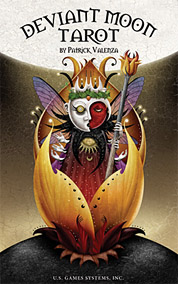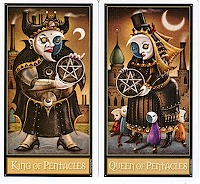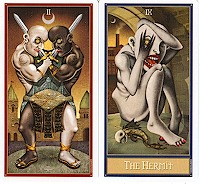By Sheri Harshberger
It seems that 2008 is the "year of the dark decks" as in addition to the Bohemian Gothic Silver Edition by Magic Realist Press, the Deviant Moon Tarot created by Patrick Valenza and published by U.S. Games Systems, Inc., has been one of the most highly anticipated decks to be released this year.
Captivated by the Tarot at an early age, Patrick Valenza pays homage to his favorites -- the old 19th century and medieval designs -- in this stylized deck, replacing the clear color block printing with the subtle tones and textures of tombstones. Bits and pieces of the surroundings of his own world were digitally manipulated and became the background and context of this deck.
The artwork is beautiful and surreal. The predominant colors are a grayish tan bordered by a sage green. The grayish tan coloring is reminiscent of an overcast day or a time of day when there is light but no discernible source such as dusk or dawn. Within this twilight world, the figures and scenes depicted are colorful and striking. At first the coloring seems to be just that, but upon further inspection, the subtle textures are visible, giving the images the look of aged stone carved inlays, which make the cards seem older than they are. The textures are continued into the figures, their clothing and any other beings or objects in each card. Throughout the deck, the image of the moon is featured, either as a crescent or full, reminding us that we are visiting an intuitive, impossible dream world. Each figure in the deck prominently features a crescent or a moon image as well -- either through the structure of its face or through an attribute of clothing or other body part -- reinforcing the idea that, like these figures, we are as much children of the moon as we are children of the sun. I found the use of the simple foundation colors of black and white to be stunning, subtly adding depth of meaning with no words necessary. The faces, when shown in profile, are either whitish or blackish, implying that the side not seen is the other color. Faces shown in full or 3/4 view show the differently colored sides, reinforcing this implication while driving home the idea that we as humans are a balance of dark and light, the yin and yang, within us. I can't help but wonder about the significance of the switching of the sides from image to image. For example, the King of Pentacles has his light side on the right, the Queen of Pentacles' is on her left. I found the 2 of Swords particularly striking as it depicts a person made up of a light and a dark person, and shows the two of them in conflict. The Hermit is also a powerful card for me, as the illumination appears to be provided through the opening of one's eyes (self-imposed darkness) to see.
The deck is the same width as a traditional deck, but slightly taller -- about 1/4 of an inch taller. I have large hands and they are almost too long for me to shuffle comfortably, but the card stock is sturdy and extremely flexible, which makes up for it. The finish is glossy which tends to make the cards very slippery against each other, but this is very manageable and the cards are easily manipulated. The backs depict an ornate, reversible pattern using crescents and circles in shades of beige or tan upon a brownish background. The stone texture prevalent throughout this deck is present in the backs as well.
In creating his deck, Patrick Valenza follows the traditional 78-card Tarot structure, with 22 cards in the Major Arcana and 56 cards in the Minor Arcana making up the deck. The Majors are numbered and only the Majors, Courts and the Aces are titled. The card titles on these cards appear across the bottom of the cards. I personally prefer no titles or borders on cards, but these are done very well and it's easy to "forget" the titles are there if I want to. The Minors are stunning in this deck as they are not titled and there is but a minimal border around the images. The Fool card is numbered 0. Justice is numbered as 8 and Strength is 11. The deck is traditionally suited with Cups, Pentacles, Swords and Wands. Elemental associations to the suits is not provided, leaving the reader free to use or not use them. Interestingly, he treats the suits as if they are familial clans and each card within the suit a member of that clan. This is reinforced through the artwork which depicts the figures in each suit similarly to each other but distinctly different from the figures depicted within the other suits.
The Deviant Moon Tarot comes packaged in a slip box that includes the deck with a little white book (LWB) and special spread sheet. The LWB has a small introduction in which Patrick Valenza talks about how the Deviant Moon Tarot came into being, followed by card meanings for both upright and reversed positions. Each suit is introduced as if they are a family or clan, with a description of their strengths and/or weaknesses. There is only one spread with instructions included in the LWB, "The Lunatic Spread." Carrying on the theme of the moon that is prevalent throughout the deck, it is circular in design to mimic the shape of the full moon. The spread sheet was a pleasant surprise for me as I was expecting yet another Celtic Cross diagram and was treated to a spread diagram for The Lunatic Spread instead.
Using this deck may tend to make people uncomfortable. Working with it for just a short while had disturbing results for me, as it immediately struck up very personal conversations with me and the family members and friends that I tested it on. Despite the surrealistic style, it's very readable, even intuitively touching people with no Tarot background.
I think now is a glorious time to be a Tarot reader and/or collector of decks. There seems to be a delicious renaissance happening, in which artists are exploring the Tarot and trying to come up with a new paradigm that fits the Tarot in the 21st century and beyond, much in the same way that the ancient, original artists inadvertently did hundreds of years ago. Patrick Valenza has taken his very personal view of the world and the Tarot and shared it with us with amazing results.



